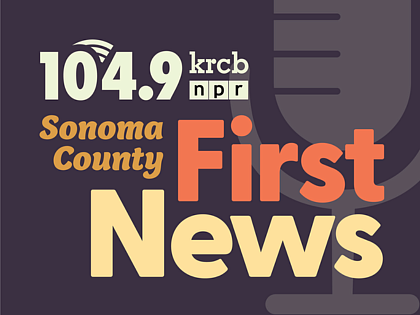 photo credit: Courtesy of Unified Symposium
photo credit: Courtesy of Unified Symposium Mike Veseth and Danny Brager at the Unified Wine & Grape Symposium in Sacramento in January 2024.
Visit any local tasting room on a busy Saturday afternoon and you’d never guess that overall wine consumption is declining.
Recent data from NielsenIQ shows that consumers are increasingly drinking less wine, swapping their glasses of pinot and chardonnay for cocktails or beer, or even nonalcoholic drinks.
“There are several reasons why wine consumption is declining,” said wine economist Mike Veseth, who addressed the issue last month at the Unified Wine & Grape Symposium in Sacramento.
“During the Covid period, I think a lot of consumers began to look at self-care and to ask themselves, what is a healthy relationship with alcohol," Veseth said. "Because not only is wine consumption declining, but consumption of beer and spirits [is] also declining.”
While wine isn’t the only beverage that’s taking a hit, it does face some unique challenges. For one thing, it’s expensive. The average price per serving for wine is typically double the cost of a serving of beer, liquor or hard seltzer.
“There's also a demographic element of it,” Veseth added. “It seems that the younger generations drink wine, but they drink wine and they drink spirits and cocktails, and they have craft beers, and they're not as focused on wine as a key consumption group was among the baby boomers.”
Beverage alcohol analyst Danny Brager, another presenter at this year’s Unified Symposium, pointed out that wine’s core consumers are mainly over the age of 65—and that’s a problem for the industry.
“Older consumers, boomers and the preceding generation, they're getting older," Brager said. "They're aging out, so at some point they're drinking less, and some of them are sadly passing on. And then the younger generation [isn’t] drinking as much wine as the boomers, so we have a replacement issue.”
To turn the tide, Brager said, the wine industry needs to do a better job of engaging with younger, multicultural consumers.
“Part of it's understanding their cultural backgrounds, what resonates with them,” Brager said. “Part of it is offering products that they're more interested in or potentially more interested in—things like lower calorie, lower alcohol by volume. They're very interested in flavors, and that's why ready-to-drink products have done very, very well.”
That makes this a great time for the wine industry to branch out and experiment, Veseth said.
“When you look at some of the successful brands, one is Stella Rosa,” Veseth said. “They've now developed a number of products that are flavored. They have a new one that is a white wine, but it's flavored with chili and pineapple.”
It’s not wine like older generations understand it, Veseth said, but that’s OK.
“If we simply make the same wine, packaging it the same way, sell it with the same message, we will get the same result,” said Veseth.
Stella Rosa isn’t the only winery that’s gotten the memo. In 2020, amid the uncertainty of pandemic lockdowns, Obsidian Wine Co. in Sonoma created a new brand called Rabbit Hole.
“We were standing around thinking, now what do we do?” said Arpad Molnar, co-founder of Obsidan. “So we went back and started to make a set of wines that we thought would be really delicious to drink and fun to drink.”
The Rabbit Hole lineup includes a hazy, sparkling pinot noir, a fizzy petite sirah and a cider-wine hybrid made with pears and sauvignon blanc. The wines are fresh and spritzy, and the bottles are sealed with crown caps—like you’d normally find on beer bottles.
“They were super popular immediately, right out of the gate,” Molnar said. “Now they're available in about 30 different states.”
Molnar said he sees the products as a way to invite more consumers into the wine tent.
“I don't think this is going to change what people drink all over the world all the time, but it's a component of it—particularly for people who are intimidated by wine or intimidated by the process, or don't see themselves naturally as wine drinkers,” Molnar said. “We want this to be an on-ramp for people into wine.”

 Live Radio
Live Radio




